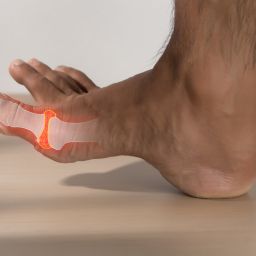
Nobody wants toe fungus. It can cause your toenails to smell, become misshapen or turn yellow. Despite the unsightly symptoms, there’s no reason to be ashamed of the fungus, as there are over three million cases of toenail fungus each year. Though seeking toenail fungus treatment treatment from your podiatrist is not always necessary, you may want to consider it if your condition is not responding to at-home treatments.
What Causes Toenail Fungus?
Fungus grows in places that are warm and damp, which explains why it grows so easily on your feet. However, there are certain factors that make your toenail more likely to get infected and thus having to seek toenail fungus treatment.
Injury or Aging
First, a broken toenail allows the fungus to get under your nail. This gives it the opportunity to spread and cause an infection. Your toenails become more likely to crack as you age, which is why older adults are more likely to need toe fungus treatment.
Going Barefoot in Public Spaces
Second, walking barefoot increases your risk of getting an infection. This is especially common in areas where multiple people are walking around barefoot, like a public locker room or shower. If one person has the infection, it can easily spread to anyone else who walks through the area without proper foot protection.
Wearing Shoes that Don’t Fit Right
Though you shouldn’t walk barefoot, you also don’t want to wear shoes that are too tight. This prevents air from getting to your feet, which, when combined with the fact that fungus grows well with moisture, increases your risk of infection. This is particularly a problem if you have sweaty feet or wear tight shoes while exercising.
Lifestyle & Genetics
Given the fact that moisture helps fungus to grow, people who spend a lot of time in the water are also at greater risk. Additionally, some people have a genetic predisposition to fungus. If anyone in your family has required toenail fungus treatment, you are more likely to need treatment.
Preventing Toenail Fungus
To prevent an infection from toenail fungus, you should regularly wash your feet, dry them when they get wet, and keep your nails short. It is also a good idea to wear shoes that let air in. Leather shoes are particularly good for this purpose.
If you have toenail fungus, you shouldn’t paint your nails. As with tight shoes, this prevents them from getting the air they need.
Following these tips now can prevent you from needing toenail fungus treatment in the future.
When Toenail Fungus Treatment is Necessary
If your problem persists despite at-home intervention, there are oral, topical and laser treatments available as well as surgery as a last resort. All treatment options have pros and cons that can be discussed with the patient. However before treatment, the podiatrist should do a biopsy and culture of the nail in order to identify the infection properly. At that point, the doctor can recommend the best approach to treating your fungus.
Contact the specialists at Certified Foot and Ankle Specialists to learn about the toenail fungus treatment methods available to you. Schedule your next appointment at 1-855-550-FEET
Frequently Asked Questions
Oral Foot Fungal Treatment:
- What is oral foot fungal treatment?
Oral foot fungal treatment refers to the use of antifungal medications that are taken orally (in pill or tablet form) to treat fungal infections on the feet, such as athlete’s foot or toenail fungus. - How do oral antifungal medications work?
Oral antifungal medications work by entering the bloodstream and targeting the fungal infection from within. They inhibit the growth and reproduction of the fungus, helping to clear the infection. - When is oral foot fungal treatment recommended?
Oral treatment is typically prescribed for severe or persistent foot fungal infections that do not respond well to topical treatments. It may also be recommended for toenail fungus that has spread to multiple nails or for individuals with weakened immune systems. - What are the common side effects of oral antifungal medications?
Common side effects may include upset stomach, headache, rash, and changes in taste. Serious side effects are rare but may include liver problems in some cases. - How long does oral foot fungal treatment usually last?
The duration of treatment varies depending on the severity of the infection and the specific medication prescribed. Treatment courses can last from a few weeks to several months.
Topical Foot Fungal Treatment:
- What is topical foot fungal treatment?
Topical foot fungal treatment involves applying antifungal creams, lotions, or ointments directly to the affected area on the feet, such as the skin or toenails, to treat fungal infections. - How do topical antifungal medications work?
Topical antifungal medications work by directly targeting the fungus on the skin or nails. They disrupt the fungal cell walls, preventing the fungus from growing and spreading. - When is topical foot fungal treatment recommended?
Topical treatments are often used for mild to moderate foot fungal infections, such as athlete’s foot or limited toenail fungus. They are generally the first line of defense before considering oral medications. - How should I apply topical antifungal medication for best results?
Follow the instructions provided by your healthcare provider or the medication’s packaging. Typically, you should clean and dry the affected area before applying the medication and continue the treatment for the prescribed duration, even if the symptoms improve. - How long does it take for topical foot fungal treatment to work?
The time it takes for improvement varies depending on the severity of the infection and the specific medication used. Some people may experience relief within a few days, while others may need several weeks of consistent application.
Laser Foot Fungal Treatment:
- What is laser foot fungal treatment?
Laser foot fungal treatment, also known as laser therapy or laser ablation, is a non-invasive procedure that uses focused laser energy to target and eliminate fungal infections on the feet, particularly toenail fungus. - How does laser foot fungal treatment work?
During the procedure, a medical professional directs the laser onto the affected area. The laser energy penetrates the toenail, targeting the fungus and destroying it without causing harm to the surrounding tissue. - Is laser foot fungal treatment painful?
The procedure is generally well-tolerated and relatively painless. Some individuals may experience a mild warming sensation during the treatment. - How many laser treatment sessions are usually required?
The number of sessions required varies depending on the severity of the fungal infection and the specific laser system used. Typically, several sessions spaced a few weeks apart are needed for optimal results. - Are there any side effects or risks associated with laser foot fungal treatment?
Laser treatment is considered safe, and serious side effects are rare. Some people may experience temporary redness or mild discomfort in the treated area, but this usually resolves quickly. However, the efficacy of laser treatment for toenail fungus may vary among individuals.


